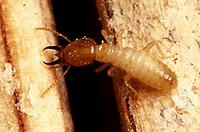
Formosan subterranean termiteWild celery and two weed species found throughout the western United States may contribute to safe, natural control of the Formosan subterranean termite, Coptotermes formosanus.
Agricultural Research Service (ARS) scientists say that, in lab tests, three compounds that they isolated from these plants scored high kill rates against the invasive termites, which cause about $1 billion in damage annually in the United States.
One compound, called apiol, was extracted from wild celery (Ligusticum hultenii), which is actually a member of the parsley family. The other compounds are cnicin, which was isolated from spotted knapweed (Centaurea maculosa), and vulgarone B, taken from Artemisia douglasiana, a variant of mugwort.
The compounds were isolated and identified by chemist Kumudini M. Meepagala at ARS' Natural Products Utilization Research Unit in Oxford, Miss. Entomologist Weste Osbrink at ARS' Formosan Subterranean Termite Research Unit in New Orleans, La., tested them for efficacy.
In those tests, Osbrink, whose unit is part of ARS' Southern Regional Research Center, found that vulgarone B and apiol are lethal and fast-acting to the termites. By the fourth day after application, vulgarone B achieved a 97 percent mortality rate, and apiol had an 80 percent rate. Both achieved 100 percent kill rates by the fifteenth day after application.
Cnicin was slower acting, with an 81 percent mortality rate 15 days after the treatment.
According to Meepagala, these compounds were present in high levels in the plants from which they were isolated. The spotted knapweed from which the cnicin was taken is a highly invasive weed in the northwestern United States, while Artemisia douglasiana is found in all of the western states.
Meepagala had previously shown that vulgarone B is an effective and fast-acting natural control of golden apple snails, which devastate Asian rice fields.
Source : ARS
 Print Article
Print Article Mail to a Friend
Mail to a Friend
